Contents
Market Overview
Macro Introduction
Reflation back in vogue or U.S. exceptionalism? Rates dominated news flow this week, at least over silver’s rise, VIX’s retreat, China’s repo reversal and EUR’s decline below 1.20 again. U.S. indices from the S&P 500 to the Russell 2000 traded up to all-time highs, as USD strengthened and U.S. Treasuries widened 9-12 bps. We continue to witness large unwinding in long EUR positions despite improving data while political risk recedes, which is often expressed via BTPS-DBR 10yr spreads, which collapsed below 100 bps as Mario Draghi increased his chances of forming an Italian government. However, calling Super Mario a success remains premature as the 132nd government since 1861 means the average tenure sits at 1.2 years. Crude oil also ended the week up 6-8% across Brent and WTI on OPEC+ discipline and strong U.S. data releases (primarily, ISM and New Orders).
EM Credit Update
EM credit ended the week up 0.3% with spreads 7 bps tighter. Lebanon, Ecuador and Tunisia outperformed, while Cameroon, Zambia and Tajikistan lagged. It is worth noting that as U.S. HY trades down to all-time lows in yield and spread, EM continues to screen as attractive. The spread pick-up in EM sovereign HY over U.S. HY is now 160 bps, while the pick-up in EM corporate HY sits at 60 bps. On a risk-adjusted and duration neutralized basis, EM corporate HY is still the sweet-spot. Further validation will come with strong inflows into the asset class. In January, we saw the largest monthly inflows into the asset class since July 2019 ($6.2bn) and this week, the largest weekly inflow since February 2019 ($2.7bn).
Week Ahead
Into next week, the focus will be on China’s CPI print and whether PPI rebounds into positive territory, all before the Lunar New Year. We are also keeping one-eye on M2 growth which is shallowing out to 9.7%, while M1 should remain modest around 9%. Most EM central banks are expected to keep rates unchanged, with the likelihood of a cut in Mexico growing (4.0%). The calendar also includes Peru (0.25%), Philippines (2.0%) and Russia (4.25%). Otherwise inflation reports out of Argentina, Brazil, Chile, Czech Republic, Hungary, Mexico and Romania are due. Turkey’s current account release has become an important feature as real financial conditions remain supportive and Lira strength continues to outperform EMFX in 2021. Elsewhere, the growth picture will be updated with GDP out of Poland and Malaysia and with industrial production data out of India after forecasting a budget deficit of 6.8% in 2021.
This week’s emerging markets highlights discussed below include the following: Mixed global PMI prints in January emphasize the theme of growth differentiation; Turkey’s inflation still accelerating in January, but the Central Bank’s (CBRT) hawkishness and restored credibility bode well for local currency assets; Alexei Navalny’s imprisonment will likely prompt new targeted sanctions by the U.S./EU against Russian individuals, but economically significant measures are unlikely; Newly elected Presidents of Brazil’s Senate and Lower House perceived as supportive of Bolsonaro’s reform agenda as 2021 is set to be another critical year for fiscal consolidation; Ethiopia announced it will seek debt relief under the G20 common framework beyond DSSI (Debt Service Suspension Initiative).
Fixed Income
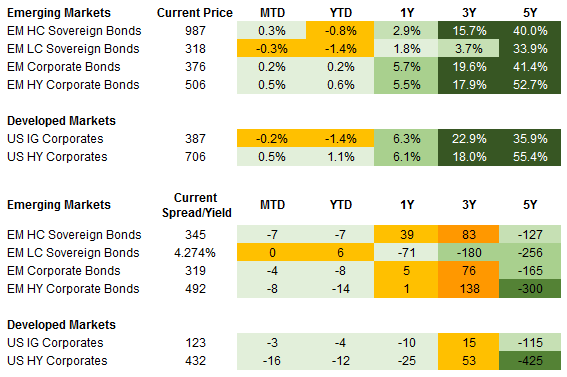
Equities
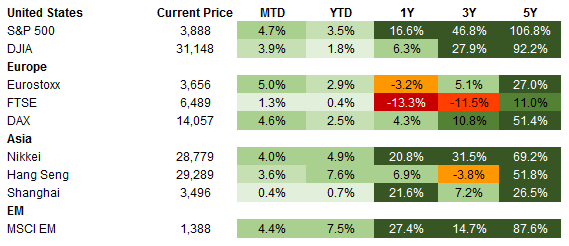
Commodities

Source for data tables: Bloomberg, JPMorgan, Gramercy. EM Fixed Income is represented by the following JPMorgan Indicies: EMBI Global, GBI-EM Global Diversified, CEMBI Broad Diversified and CEMBI Broad High Yield. DM Fixed Income is represented by the JPMorgan JULI Total Return Index and Domestic High Yield Index. Fixed Income, Equity and Commodity data is as of February 5, 2021 (Mid Afternoon).
Emerging Markets Weekly Highlights
Mixed global PMI prints in January emphasize the theme of growth differentiation
Event: The U.S. Markit composite PMI improved by 3.4 pts to 58.7 pts following moderation in December. The services component also performed fairly well relative to expectations while the EU and Japan composites dipped deeper into contractionary territory. In China, Caixin composite PMI data moderated by 3.6 pts but remained comfortably within expansion territory at 52.2 pts. The services sector underperformed expectations while new export orders dropped into contractionary territory amid increased domestic and global COVID-19 related restrictions. Russia, Turkey, and India are among the major EM economies which saw notable improvements while Brazil PMI dropped 4.6 pts to 48.9 pts.
Gramercy Commentary: The variation of the ebb and flow of the COVID-19 virus combined with vaccine rollout and effectiveness across countries should continue to drive differentiated growth outcomes. In the U.S., easing of the latest virus wave, lifting of lockdown restrictions, virus fatigue and positive vaccine momentum contributed to outperformance. Markets will continue to watch the services sector closely for indications of a more complete recovery as well as prospects for near and medium term fiscal stimulus. Amid stronger data, but a still incomplete recovery and tolerance for higher transient inflation, we expect the Fed to remain highly supportive but envisage the need for more frequent guidance and rhetoric as yields move higher throughout the year. In China, increased restrictions amid an uptick in virus cases as well as a slowdown in credit growth likely contributed to the easing of activity momentum. This may spillover into February albeit base effects should be quite strong. We expect the PBOC to remain cautious with respect to moderation of liquidity conditions and growth to remain robust with only modest easing in sequential momentum as the year progresses.
Turkey’s inflation still accelerating in January, but the Central Bank’s (CBRT) hawkishness and restored credibility bode well for local currency assets
Event: January headline CPI came at 15% YoY, accelerating from 14.6% in December and overshooting consensus expectations of 14.7%. The January inflation print was mainly driven by lagged effects of the Turkish Lira (TRY) depreciation throughout most of 2020 and lending-fueled domestic demand before the CBRT started to tighten monetary policy in November of last year.
Gramercy Commentary: Under its new leadership, the CBRT continues to send the right messages, including a strong hawkish signal to markets last week during its inflation outlook presentation, targeting single digit (9.4%) inflation by year-end and a more aspirational/ambitious 5% structural objective by end-2022. In that context, we think monetary policy will remain tight and can get even tighter, if necessary. Despite the overshoot by January’s inflation, market consensus remains that the hiking cycle is now over and the CBRT will prefer to rely on hawkish rhetoric going forward. We agree with the market that the CBRT’s rhetoric will remain hawkish and market friendly, but we believe that a measured additional rate hike is not off the table for the next monetary policy meeting on February 18 in order to maintain onshore ex-post real rates of around 250 bps as well as reinforce the CBRT’s reestablished independence and credibility. Against that backdrop, we believe the impressive rally staged by the TRY since November has further room to go. Tailwinds for the currency include some of the highest real rates in global EM, still light foreign positioning and the prospect for reversal of dollarization in local bank deposits.
Alexei Navalny’s imprisonment will likely prompt new targeted sanctions by the U.S./EU against Russian individuals, but economically significant measures are unlikely
Event: Russian opposition leader and dissident, Alexei Navalny, was sentenced this week to two years and eight months in prison in addition to the ten months he has already served earlier under house arrest. The authorities arrested Navalny upon his return to Russia from Germany where he received medical treatment following his poisoning last year. The arrest prompted significant street protests by his supporters across Russia.
Gramercy Commentary: Navalny’s prison sentence and street protests across Russia over the last couple of weeks have re-focused market attention on the risks/probabilities around potential new economic sanctions against Russia by the U.S. and Europe. Although Navalny’s imprisonment and the harsh treatment by police of his supporters will likely result in the West imposing new sanctions on Russia, our view is that they will not be too punitive from a market/macroeconomic perspective. Most likely, new measures will be limited to sanctions for human rights violations that target Russian government officials and other individuals directly involved in the Navalny case. Political pressure in the U.S. and Europe for more significant actions such as new sanctions on sovereign debt is likely to increase in light of the recent developments, but we are of the opinion that such a scenario carries a low probability. Our assessment could change if the political turmoil in Russia escalates dramatically, which is unlikely given President Putin’s relatively strong support and Navalny’s relatively small one. We think the Biden Administration will be reluctant to start its diplomatic relationship with Moscow on the wrong foot in the context of several major global issues (climate change, nuclear arms control, counter-terrorism) on which the White House and Kremlin share common interest to cooperate. As for the EU, the limiting factors are even stronger. Brussels has signaled a preference to coordinate its policy response with the U.S. and there is a block of member-states (i.e. Hungary, Italy, and Greece, among others) that tend to oppose any harsh measures against Russia, which makes the deployment of biting EU sanctions highly unlikely. As such, we are of the view that Russian assets have too much political risk premium embedded in them, especially the RUB, which has lagged the general EMFX rally since the U.S. elections in November 2020.
Newly elected Presidents of Brazil’s Senate and Lower House perceived as supportive of Bolsonaro’s reform agenda as 2021 is set to be another critical year for fiscal consolidation
Event: Arthur Lira of the Brazilian Progressive Party (PP) and Rodrigo Pacheco of the Democratic party (DEM), both center-right politicians who are perceived as friendly to the Bolsonaro Administration, were elected Presidents of Brazil’s Chamber of Deputies and Federal Senate, respectively.
Gramercy Commentary: As we have written previously, the outcome of the two speakership races in Brazil’s Congress, especially the one in the Lower House, has material market implications because it will influence the reform agenda during the last two years of the Bolsonaro Administration. Most of all, fiscal reform momentum, or lack thereof, will be a key determinant of investor sentiment on Brazil this year as markets will be looking for tangible fiscal consolidation measures in the aftermath of extraordinary fiscal policy loosening to support the economy in 2020. In that context, having like-minded policy-makers in control of Congress’ agenda is critical for the government and Brazil’s credit trajectory going forward. As such, the election of Lira and Pacheco is credit-positive, but the reform challenges ahead are numerous and formidable. In 2020, the Bolsonaro Administration decided to go “all in” on fiscal stimulus to cushion the economic shock, which “bought” the Brazilian economy a relatively small recession by borrowing even more fiscal space from the future. Brazil’s real GDP is estimated to have contacted by just 4.5% YoY last year (for comparison, Mexico’s estimated contraction in 2020 is twice as large at -8.8% YoY), but at the expense of a record-breaking budget deficit of close to 15% of GDP and government debt burden reaching north of 90% of GDP. We believe that in 2021 market participants will be willing to give Brazil the benefit of the doubt on a narrative of a relatively stronger growth, but only if accompanied by credible steps on unwinding the enormous fiscal stimulus deployed in 2020. Overall, this year is shaping up as very important one for fiscal consolidation in Brazil, given the significant policy easing in 2020 and the window of opportunity likely closing in 2022 due to presidential and general elections in the fall of next year.
Ethiopia announced it will seek debt relief under the G20 common framework beyond DSSI (Debt Service Suspension Initiative)
Events: Last Friday, Ethiopia’s finance ministry announced that the government would pursue debt review and relief under the new G20 common framework. The framework was formulated and published in November aiming to provide a process for holistic and timely debt treatments for DSSI-eligible countries beyond the DSSI that currently runs through June 2021. The framework states that participating countries will be required to seek comparable treatment across external creditors, including the private sector. The authorities are working with the IMF on an updated DSA (debt sustainability assessment) which will provide the government and its financial advisor, Lazard, with greater clarity on the debt approach. This would be the first country with outstanding Eurobonds to utilize the common framework. Ethiopia’s 2024 USD bond initially dropped over 7 pts to 93.7 cents on the dollar on the news but have partially retraced some of the losses.
Gramercy Commentary: The announcement appears opportunistic and preemptive as the government copes with the ongoing pandemic as well as increased political volatility in the northern region of Tigray. While the IMF has previously deemed debt sustainability at high risk, headline metrics are not as bleak as some peers with debt to GDP of 60%, interest to revenue of 4.5%, and USD market debt of just 3.5% of total external debt. FX reserves of under $3bn versus total external debt of $27.8bn is the more challenging element over the medium-term. The government’s opaque comments on its approach to its Eurobond as well as the unclear nature of the enforceability of comparable treatment for the private sector under the common framework indicates that the outlook and timing for an ultimate bond restructuring is uncertain. Contagion to other eligible countries has remained muted amid the favorable external backdrop and the fact that it remains up to countries to pursue relief under the common framework. Greater risk premium may begin to solidify in select high risk credits that require support amid a higher USD rate environment as the year progresses.
Emerging Markets Technicals
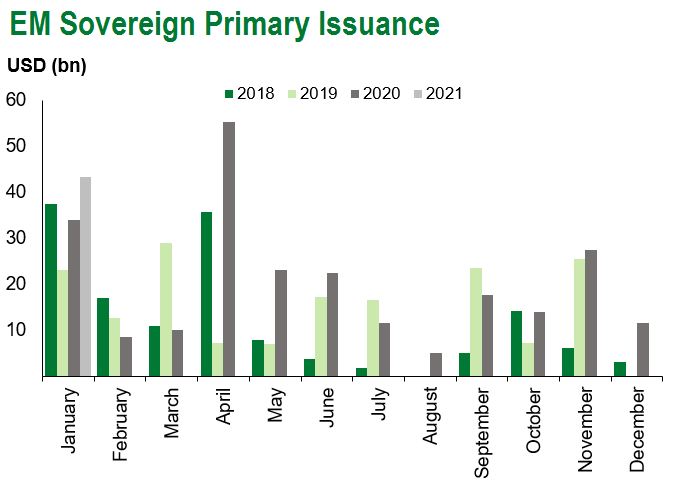
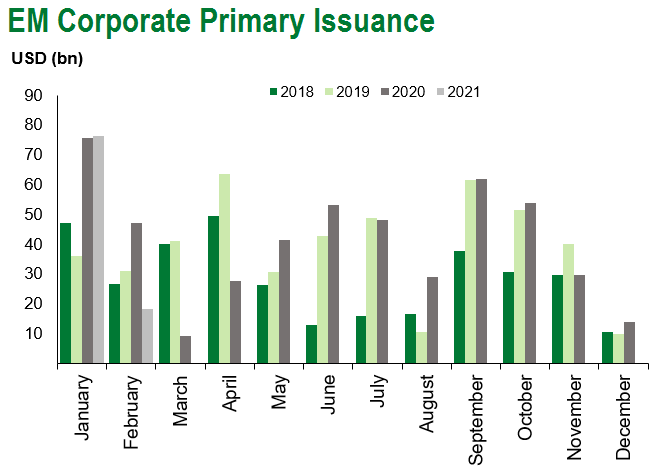
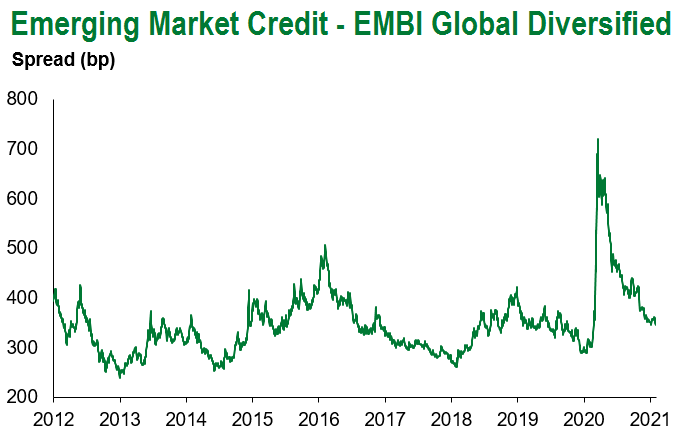

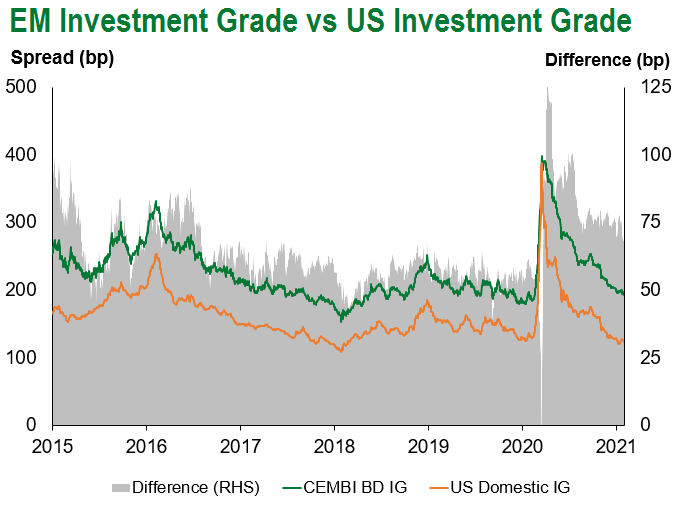
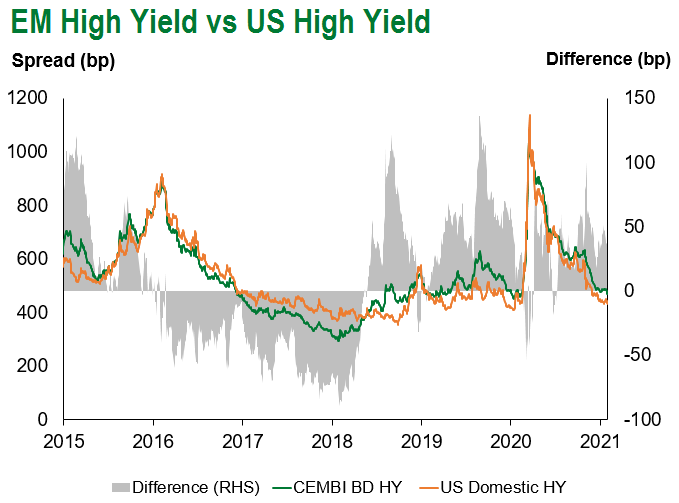
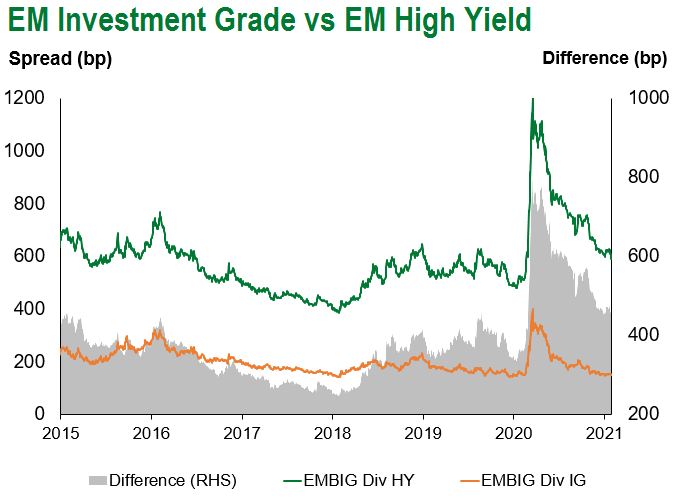
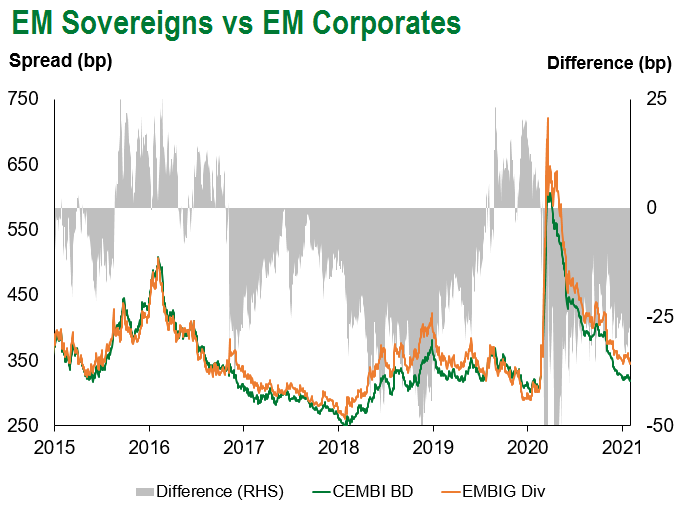
Emerging Markets Flows
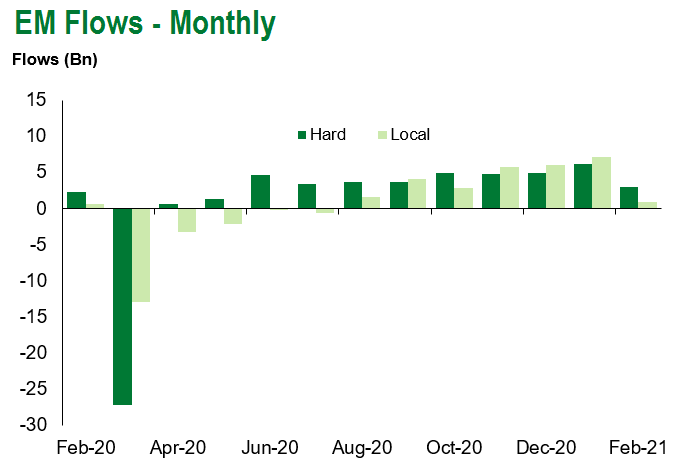
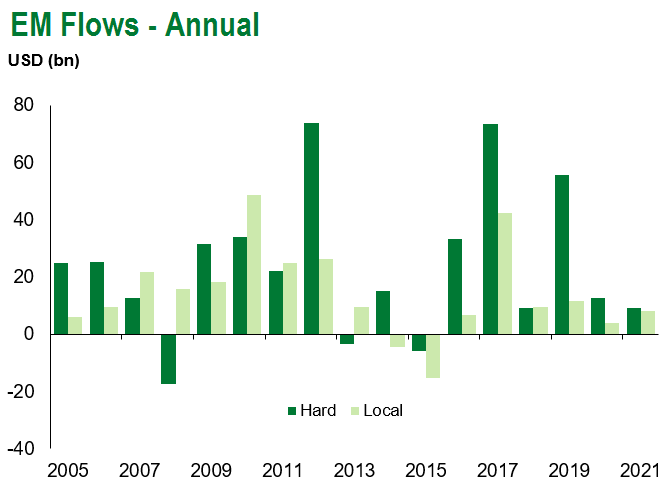
Source for graphs: Bloomberg, JPMorgan, Gramercy. As of February 5, 2021.
COVID Resources
Emerging Markets COVID-19 Case Summary
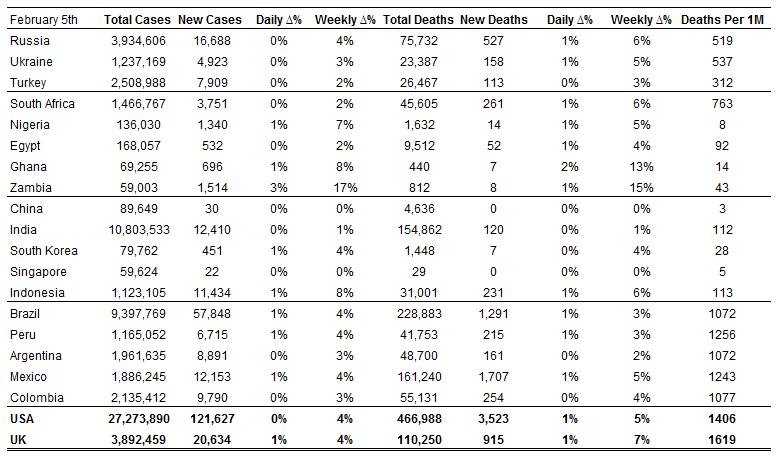
Source: Worldometer as of February 5, 2021.
Additional Crisis Resources:
Johns Hopkins COVID-19 Case Tracker
For questions, please contact:
Kathryn Exum, Senior Vice President, Sovereign Research Analyst, [email protected]
Petar Atanasov, Senior Vice President, Sovereign Research Analyst, [email protected]
Tolu Alamutu,CFA, Senior Vice President, Corporate Research Analyst, [email protected]
James Barry, Vice President, Corporate Research Analyst, [email protected]
This document is for informational purposes only. The information presented is not intended to be relied upon as a forecast, research or investment advice, and is not a recommendation, offer or solicitation to buy or sell any securities or to adopt any investment strategy. Gramercy may have current investment positions in the securities or sovereigns mentioned above. The information and opinions contained in this paper are as of the date of initial publication, derived from proprietary and nonproprietary sources deemed by Gramercy to be reliable, are not necessarily all-inclusive and are not guaranteed as to accuracy. This paper may contain “forward-looking” information that is not purely historical in nature. Such information may include, among other things, projections and forecasts. There is no guarantee that any forecasts made will come to pass. Reliance upon information in this paper is at the sole discretion of the reader. You should not rely on this presentation as the basis upon which to make an investment decision. Investment involves risk. There can be no assurance that investment objectives will be achieved. Investors must be prepared to bear the risk of a total loss of their investment. These risks are often heightened for investments in emerging/developing markets or smaller capital markets. International investing involves risks, including risks related to foreign currency, limited liquidity, less government regulation, and the possibility of substantial volatility due to adverse political, economic or other developments. The information provided herein is neither tax nor legal advice. Investors should speak to their tax professional for specific information regarding their tax situation.